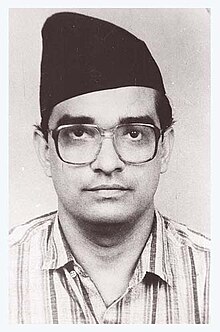Madan Kumar Bhandari
| Madan Kumar Bhandari | |
|---|---|
 |
|
| Native name | मदन कुमार भण्डारी |
| Born |
27 June 1951 Dhungesangu Village, Taplejung, Nepal |
| Died | 16 May 1993 (aged 41) Dasdhunga, Chitwan, Nepal |
| Cause of death | Possibly murdered (car accident) |
| Body discovered | Three days later at Dasdhunga, Chitwan, Nepal |
| Resting place | Arya Ghat, Pashupati |
| Monuments | Madan Bhandari Memorial College, Madan-Ashrit Highway, Madan Bhandari Road |
| Residence | Kathmandu and Jhapa |
| Nationality | Nepalese |
| Other names | जनताका नेता (People's leader), जननेता |
| Citizenship | Nepali |
| Known for | जनताको बहुदलीय जनवाद "People's Multiparty Democracy" |
| Notable work | Refrendum |
| Political party | Communist Party of Nepal (Unified Marxist-Leninist) |
| Movement | People's Movement I (1990) |
| Opponent(s) | Panchayat system |
| Spouse(s) | Bidhya Devi Bhandari |
| Children | 2 |
Madan Kumar Bhandari (Nepali: मदनकुमार भण्डारी) (27 June 1951 – 16 May 1993) was a Nepalese politician and communist leader. He was sensational youth Communist leader who rose to prominence after being party leader and defeating great rival leader Krishna Prasad Bhattarai in the general election. The New York Times featured him, writing, "Karl Marx lives in Nepal."
Bhandari was born in Dhungesangu village of Taplejung district of eastern Nepal. He studied in Medibung School in Taplejung and in Varanasi, India. In 1972, he became the central committee member of the Janabadi Sanskritik Morcha (Democratic Cultural Front), a student movement launched by Pushpa Lal Shrestha. Around 1976, he left Pushpa Lal's Communist Party of Nepal to launch the Mukti Morcha Samuha ("Liberation Front Group"), which formed an alliance with the survivors of the Jhapa Movement in 1978. He was a founder member of the Communist Party of Nepal (Marxist-Leninist) preceding the 1980 referendum and was elected general secretary at its fourth national in 1986.
When CPN (ML) merged into the Communist Party of Nepal (Unified Marxist-Leninist) in 1991, Bhandari became the general secretary. He was the engineer behind the program of CPN (UML) "People's Multiparty Democracy"), which led his party as the strongest communist party of Nepal for several years even after his death.
The UML party, under the leadership of Bhandari, won all but one seat in the Himalayan capital in 1991 elections, the country's first free elections in more than three decades. "It is a vote for democracy. It is a vote for independence. It is a vote for the alleviation of poverty," said Bhandari afterwards.
He believed that the way for communists to gain power was through popular vote and not radical armed movements. However, shortly after the elections, he died mysteriously in a car accident in Dasdhunga, Chitwan.
...
Wikipedia
